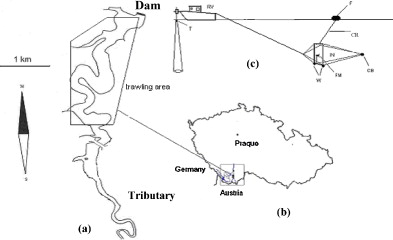 The efficiency of different sized (0.5 m × 2 m, 1 m × 2 m, 2 m × 2 m, 4 m × 2 m) and coloured (black, white) ichthyoplankton trawl nets was investigated during daytime in the bathypelagic layer of the Římov Reservoir (Czech Republic) in late May 2008. Eight to 16 mm long perch (Perca fluviatilis) and pikeperch (Sander lucioperca) fry were the dominant species in fry catches in this layer. We did not find any significant differences between the densities of either species when black and white nets were compared or when different sized nets were compared. Neither were there any significant differences in body lengths of the fish caught in the different trawls. Our results indicate that both perch and pikeperch fry in the bathypelagic layer are quite passive, without observable avoidance behaviour to the ichthyoplankton trawl nets. This is in contrast to active avoidance of the same species and sizes previously observed in the epipelagic layer.
The efficiency of different sized (0.5 m × 2 m, 1 m × 2 m, 2 m × 2 m, 4 m × 2 m) and coloured (black, white) ichthyoplankton trawl nets was investigated during daytime in the bathypelagic layer of the Římov Reservoir (Czech Republic) in late May 2008. Eight to 16 mm long perch (Perca fluviatilis) and pikeperch (Sander lucioperca) fry were the dominant species in fry catches in this layer. We did not find any significant differences between the densities of either species when black and white nets were compared or when different sized nets were compared. Neither were there any significant differences in body lengths of the fish caught in the different trawls. Our results indicate that both perch and pikeperch fry in the bathypelagic layer are quite passive, without observable avoidance behaviour to the ichthyoplankton trawl nets. This is in contrast to active avoidance of the same species and sizes previously observed in the epipelagic layer.
Keywords: ichthyoplankton trawl; Perca fluviatilis; perch; percids avoidance reaction; pikeperch; Římov Reservoir; Sander lucioperca
